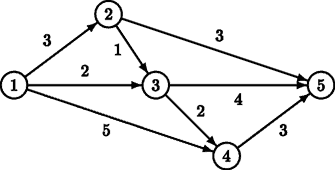3463 Sightseeing(最短路和次短路計數)
Sightseeing
| Time Limit: 2000MS | Memory Limit: 65536K |
| Total Submissions: 10522 | Accepted: 3745 |
Description
Tour operator Your Personal Holiday organises guided bus trips across the Benelux. Every day the bus moves from one city S to another city F. On this way, the tourists in the bus can see the sights alongside the route travelled. Moreover, the bus makes a number of stops (zero or more) at some beautiful cities, where the tourists get out to see the local sights.
Different groups of tourists may have different preferences for the sights they want to see, and thus for the route to be taken from S to F. Therefore, Your Personal Holiday wants to offer its clients a choice from many different routes. As hotels have been booked in advance, the starting city S and the final city F
There is a restriction on the routes that the tourists may choose from. To leave enough time for the sightseeing at the stops (and to avoid using too much fuel), the bus has to take a short route from S

For example, for the above road map, there are two minimal routes from S = 1 to F = 5: 1 → 2 → 5 and 1 → 3 → 5, both of length 6. There is one route that is one distance unit longer: 1 → 3 → 4 → 5, of length 7.
Now, given a (partial) road map of the Benelux and two cities S and F, tour operator Your Personal Holiday likes to know how many different routes it can offer to its clients, under the above restriction on the route length.
Input
The first line of the input file contains a single number: the number of test cases to follow. Each test case has the following format:
-
One line with two integers N and M, separated by a single space, with 2 ≤ N ≤ 1,000 and 1 ≤ M ≤ 10, 000: the number of cities and the number of roads in the road map.
-
M lines, each with three integers A, B and L, separated by single spaces, with 1 ≤ A, B ≤ N, A ≠ B and 1 ≤ L ≤ 1,000, describing a road from city A to city B with length L.
The roads are unidirectional. Hence, if there is a road from A to B, then there is not necessarily also a road from B to A. There may be different roads from a city A to a city B.
-
One line with two integers S and F, separated by a single space, with 1 ≤ S, F ≤ N and S ≠ F: the starting city and the final city of the route.
There will be at least one route from S to F.
Output
For every test case in the input file, the output should contain a single number, on a single line: the number of routes of minimal length or one distance unit longer. Test cases are such, that this number is at most 109 = 1,000,000,000.
Sample Input
2 5 8 1 2 3 1 3 2 1 4 5 2 3 1 2 5 3 3 4 2 3 5 4 4 5 3 1 5 5 6 2 3 1 3 2 1 3 1 10 4 5 2 5 2 7 5 2 7 4 1
Sample Output
3 2
Hint
The first test case above corresponds to the picture in the problem description.
dis[x][2]:dis[x][0]表示起點到x的最短路、dis[x][1]表示起點到x的次短路;
cnt[x][2]:cnt[x][0]表示起點到x的最短路條數、cnt[x][1]表示起點到x的次短路的條數;
vis[x][2]對應於x和0、1功能為記錄該點是否被訪問!
那麼如何更新最小和次小路呢?顯然我們容易想到下面的方法:
1.if(x<最小)更新最小,次小; 2.else if(x==最小)更新方法數; 3.else if(x<次小)更新次小; 4.else if(x==次小)更新方法數;
#include <stdio.h>
#include <string.h>
#include <queue>
using namespace std;
const int MAXN = 1005;
const int MAXM = 20005;
const int INF = 0x3f3f3f3f;
int head[MAXN],tot;
struct Edge
{
int to,Next,w;
}edge[MAXM];
void init()
{
tot = 0;
memset(head,-1,sizeof(head));
}
void addedge(int u,int v,int w)
{
edge[tot].to = v;
edge[tot].w = w;
edge[tot].Next = head[u];
head[u] = tot++;
}
bool vis[MAXN][2];
int dis[MAXN][2],cnt[MAXN][2];
struct Node
{
int u,dis,flag;
Node(){}
Node(int _u,int _dis,int _flag)
{
u = _u;
dis = _dis;
flag = _flag;
}
bool operator<(const struct Node& a) const
{
return dis > a.dis;
}
};
void Dijkstra(int s)
{
struct Node t;
int u,v,flag;
memset(dis,INF,sizeof(dis));
memset(vis,false,sizeof(vis));
memset(cnt,0,sizeof(cnt));
dis[s][0] = 0;
cnt[s][0] = 1;
priority_queue<Node> pq;
pq.push(Node(s,dis[s][0],0));
while(!pq.empty()) {
t = pq.top();
pq.pop();
u = t.u;
flag = t.flag;
if(vis[u][flag]) continue;
vis[u][flag] = true;
for(int i = head[u]; i != -1; i = edge[i].Next) {
int w = edge[i].w + t.dis;
v = edge[i].to;
//printf("%d\n",v);
if(w < dis[v][0]) {
if(dis[v][0] != INF) {
dis[v][1] = dis[v][0];
cnt[v][1] = cnt[v][0];
pq.push(Node(v,dis[v][1],1));
}
dis[v][0] = w;
cnt[v][0] = cnt[u][flag];
pq.push(Node(v,w,0));
}
else if(w == dis[v][0]) {
cnt[v][0] += cnt[u][flag];
}
else if(w == dis[v][1]) {
cnt[v][1] += cnt[u][flag];
}
else if(w < dis[v][1]) {
dis[v][1] = w;
cnt[v][1] = cnt[u][flag];
pq.push(Node(v,dis[v][1],1));
}
}
}
}
int main(void)
{
int T,u,v,w,n,m,s,e,ans;
scanf("%d",&T);
while(T--) {
init();
scanf("%d %d",&n,&m);
while(m--) {
scanf("%d %d %d",&u,&v,&w);
addedge(u,v,w);
}
scanf("%d %d",&s,&e);
Dijkstra(s);
ans = dis[e][0] + 1 == dis[e][1] ? cnt[e][0] + cnt[e][1] : cnt[e][0];
printf("%d\n",ans);
}
return 0;
}
